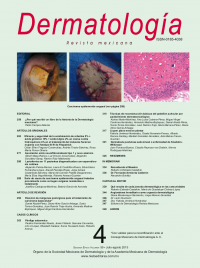Resumen
Antecedentes: la esporotricosis es una infección fúngica crónica causada por el complejo Sporothrix schenckii, se distingue por granulomas epitelioides, tuberculoides o de cuerpo extraño, formados por histiocitos que rodean un área central de neutrófilos que contribuyen en el sistema de inmunidad inespecífica. En los polimorfonucleares neutrófilos se encuentra la lactoferrina que ejerce una acción protectora contra hongos y levaduras; el efecto antifúngico se atribuye a su capacidad de secuestrar un átomo de Fe+2 o Fe+3, y también puede unirse a iones Cu+2, Zn+2 y Mn+. Existe evidencia de que la lactoferrina aumenta la actividad fagocítica de los neutrófilos sanguíneos, la actividad de las células NK, el número de células progenitoras de neutrófilos en la sangre y la producción de interferón gamma, es capaz de mostrar actividad antimicrobiana en un amplio espectro de agentes patógenos, entre los que se incluyen bacterias, levaduras, hongos, protozoarios y virus. Objetivo: demostrar la existencia de lactoferrina sobre las levaduras de Sporothrix sp, presentes en los cortes histológicos de pacientes con esporotricosis cutánea. Material y método: estudio retrospectivo en el que se usaron 11 biopsias de pacientes con diagnóstico de esporotricosis cutánea, atendidos en el Centro Dermatológico Ladislao de la Pascua y el Hospital General Dr. Manuel Gea González. Se realizaron dos cortes por biopsia, uno para la realización de la técnica de PAS y el otro para el marcaje de lactoferrina. Se utilizó el paquete comercial Cell and Tissue Staining Kit, Goat Kit HRP-AEC System (catálogo número CTS009) R&D Systems, y el anticuerpo primario fue el IgG policlonal anti-lactoferrina humana hecho en cabra por los laboratorios Santa Cruz Biotechnology. Resultados: encontramos lactoferrina adherida a las levaduras de Sporothrix sp, previamente observadas por la reacción de PAS en los cortes estudiados de los 11 pacientes diagnosticados con esporotricosis. Conclusión: la lactoferrina presente en los gránulos específicos de los neutrófilos polimorfonucleares la encontramos adherida a las levaduras del complejo Sporothrix schenckii, ejerciendo la función de secuestro de iones Fe+2 y Fe+3, tratando de evitar el desarrollo y la proliferación de este hongo en la esporotricosis cutánea.
Palabras clave: lactoferrina, esporotricosis cutánea, Sporothrix schenkii
Abstract
Background: Sporotrichosis is a chronic fungal infection caused by the Sporothrix schenckii complex, is characterized by the presence of granulomas of epithelioid, tuberculoid or foreign body composed of histiocytes surrounding a central area of neutrophils that contribute to the non-specific immune system. Neutrophils are in lactoferrin which exerts a protective action against fungi and yeasts, attributing the antifungal effect to its ability to sequester an atom of Fe+2 or Fe+3, and they can also join to Cu+2, Zn+2 and Mn+ ions. There is evidence that lactoferrin activity increases blood neutrophil phagocytic activity of NK cells, the number of cells progenitors of neutrophils in the blood and the production of gamma interferon; it is able to display antimicrobial activity on a broad spectrum of pathogens among including: bacteria, yeasts, fungi, protozoa and viruses. Objective: To demonstrate the presence of lactoferrin in Sporothrix sp yeasts present on the histological sections of patients with cutaneous sporotrichosis. Material and method: A retrospective study in which 11 biopsies of patients with diagnosis of cutaneous sporotrichosis attended at Dermatological Center Ladislao de la Pascua and General Hospital Dr. Manuel Gea González, both in Mexico City, were included. Two cuts were made by biopsy, one for the realization of the technique of PAS and the other for the marking of the lactoferrin. We used the commercial kit Cell and Tissue Staining Kit, Goat Kit HRP-AEC System (catalog no. CTS009) R&D Systems, and the primary antibody that was used was the IgG polyclonal anti-human lactoferrin made in goat by Santa Cruz Biotechnology laboratories. Results: We found the presence of lactoferrin on yeasts of Sporothrix sp, previously observed by the reaction of PAS in the studied sections of the 11 patients, already diagnosed with sporotrichosis. Conclusion: It was found lactoferrin present in the specific granules of polymorphonuclear neutrophils attached to the yeasts of the Sporothrix schenckii complex, engaged in kidnapping of ions Fe+2 and Fe+3 function, trying to prevent the development and proliferation of this fungus in the cutaneous sporotrichosis.
Keywords: lactoferrin, Sporothrix schenkii, cutaneous sporotrichosis

